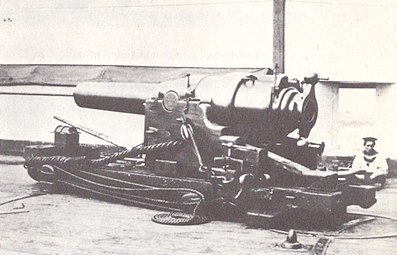
A heavy cruiser was a type of cruiser, a naval warship designed for long range and high speed, armed generally with naval guns of roughly 203 mm (8 inches) in calibre, whose design parameters were dictated by the Washington Naval Treaty of 1922 and the London Naval Treaty of 1930. Heavy cruisers were generally larger, more heavily-armed and more heavily-armoured than light cruisers while being smaller, faster, and more lightly-armed and armoured than battlecruisers and battleships. Heavy cruisers were assigned a variety of roles ranging from commerce raiding to serving as 'cruiser-killers,' i.e. hunting and destroying similarly-sized ships.

The armored cruiser was a type of warship of the late 19th and early 20th centuries. It was designed like other types of cruisers to operate as a long-range, independent warship, capable of defeating any ship apart from a battleship and fast enough to outrun any battleship it encountered.

An ironclad was a steam-propelled warship protected by steel or iron armor constructed from 1859 to the early 1890s. The ironclad was developed as a result of the vulnerability of wooden warships to explosive or incendiary shells. The first ironclad battleship, Gloire, was launched by the French Navy in November 1859, narrowly preempting the British Royal Navy. However, Britain built the first completely iron-hulled warships.
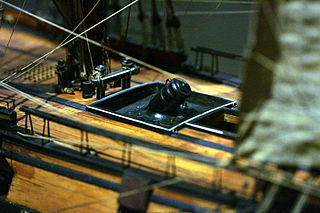
A bomb vessel, bomb ship, bomb ketch, or simply bomb was a type of wooden sailing naval ship. Its primary armament was not cannons – although bomb vessels carried a few cannons for self-defence – but mortars mounted forward near the bow and elevated to a high angle, and projecting their fire in a ballistic arc. Explosive shells or carcasses were employed rather than solid shot. Bomb vessels were specialized ships designed for bombarding fixed positions on land. In the 20th century, this naval gunfire support role was carried out by the most similar purpose-built World War I- and II-era monitors, but also by other warships now firing long-range explosive shells.

The QF 4.5 inch gun has been the standard medium-calibre naval gun used by the Royal Navy as a medium-range weapon capable of use against surface, aircraft and shore targets since 1938. This article covers the early 45-calibre family of guns up to the 1970s. For the later unrelated 55-calibre Royal Navy gun, see 4.5 inch Mark 8 naval gun. Like all British nominally 4.5 inch naval guns, the QF Mk I has an actual calibre of 4.45 inches (113 mm).

Coastal artillery is the branch of the armed forces concerned with operating anti-ship artillery or fixed gun batteries in coastal fortifications. In modern times, coastal artillery has generally been replaced with anti-ship missiles, such as the Ukrainian R-360 Neptune.
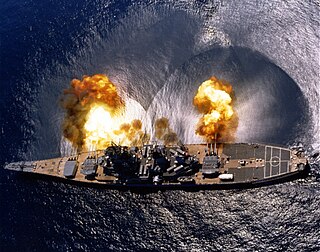
Naval artillery is artillery mounted on a warship, originally used only for naval warfare and then subsequently used for more specialized roles in surface warfare such as naval gunfire support (NGFS) and anti-aircraft warfare (AAW) engagements. The term generally refers to powder-launched projectile-firing weapons and excludes self-propelled projectiles such as torpedoes, rockets, and missiles and those simply dropped overboard such as depth charges and naval mines.

A gun turret is a mounting platform from which weapons can be fired that affords protection, visibility and ability to turn and aim. A modern gun turret is generally a rotatable weapon mount that houses the crew or mechanism of a projectile-firing weapon and at the same time lets the weapon be aimed and fired in some degree of azimuth and elevation.
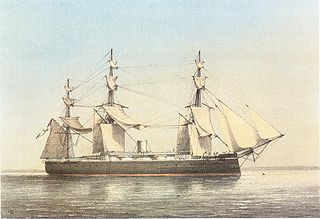
HMS Monarch was the first seagoing British warship to carry her guns in turrets, and the first British warship to carry guns of 12-inch (300 mm) calibre.
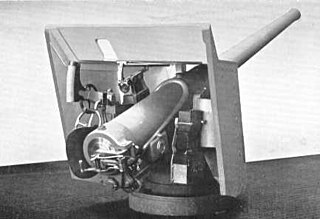
The QF 4.7-inch gun Mks I, II, III, and IV were a family of British quick-firing 4.724-inch (120 mm) naval and coast defence guns of the late 1880s and 1890s that served with the navies of various countries. They were also mounted on various wheeled carriages to provide the British Army with a long-range gun. They all had a barrel of 40 calibres length.

A deck gun is a type of naval artillery mounted on the deck of a submarine. Most submarine deck guns were open, with or without a shield; however, a few larger submarines placed these guns in a turret.
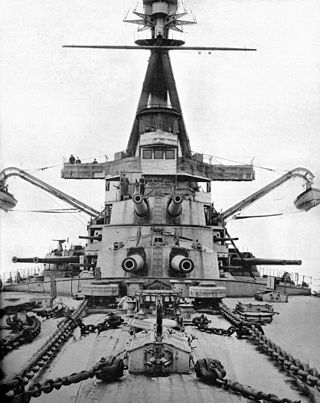
Superfiring armament is a naval military building technique in which two or more turrets are located one behind the other, with the rear turret located above ("super") the one in front so that it can fire over the first. This configuration meant that both forward and aft turrets could fire at any target within their sector, even when the target was directly ahead of the turrets.
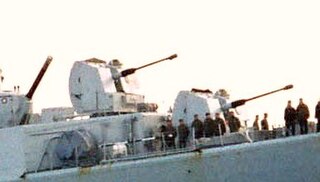
The 76mm/L62 Allargato is a single barrel, medium caliber, dual purpose automatic naval cannon designed and produced in the 1960s by the Italian defence firm of OTO-Melara as the cannon armament for all medium and large warships built for the Italian Navy in that decade. Currently, the gun remains in service with Italy's Cassiopea-class patrol vessels but has otherwise been largely replaced by the Otobreda 76 mm series of cannons.

The 15 cm SK L/40 was a German naval gun that was used as secondary armament on pre-dreadnought battleships, protected cruisers and armored cruisers of the Imperial German Navy in World War I. It was also used as a coast-defence gun during World Wars I and II.

The 8.8 cm SK L/30 (SK - SchnelladekanoneL - Länge was a German naval gun that was used in World War I on a variety of mounts.

The two British Devastation-class battleships of the 1870s, HMS Devastation and HMS Thunderer, were the first class of ocean-going capital ship that did not carry sails, and the first which mounted the entire main armament on top of the hull rather than inside it.

The EOC 10 inch 40 caliber guns were a family of related guns designed by the Elswick Ordnance Company and produced by Armstrong Whitworth in the 1890s for export customers. EOC 10 inch 40 caliber guns were the primary armament of armored cruisers, ironclads and pre-dreadnought battleships built or refit during the 1890s. These guns and their licensed derivatives armed ships of the Argentine Navy, Imperial Japanese Navy, Regia Marina and Spanish Navy. They served in the Russo-Japanese War, Italo-Turkish War and World War I.

The Škoda 10 cm K10 was a 100 mm (3.9-inch) naval gun of the Austro-Hungarian Navy used as tertiary armament on semi-dreadnought battleships and as primary armament on scout cruisers and destroyers during World War I. After World War I, variants of the Škoda 10 cm K10 were widely produced in Italy as the 100/47 series of guns, which served in a number of roles, on a wide variety of ships, with a number of navies.
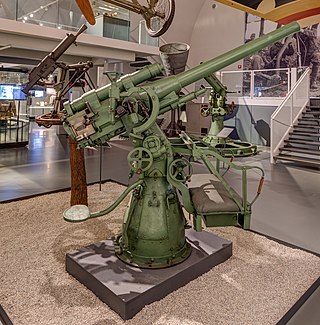
The Škoda 7 cm K10 was a dual-purpose gun of the Austro-Hungarian Empire that was used by the Austro-Hungarian Navy during World War I. The gun was actually 66 mm, but the classification system for artillery rounded up to the next highest centimeter. The 7 cm K10 was also used by the Italian Navy on ships ceded as war reparations and as coastal artillery during World War II. The Italians referred to it as the 66/47.

The EOC 8 inch 45 caliber were a family of related 8-inch (203 mm) 45 caliber naval guns designed by the Elswick Ordnance Company and manufactured by Armstrong for export customers before World War I. In addition to being produced in the United Kingdom licensed variants were produced in Italy and in Japan. Users of this family of gun included the navies of Argentina, Chile, China, Italy, Japan and Spain. This family of guns saw action in the Spanish–American War, Boxer Rebellion, Russo-Japanese War, Italo-Turkish War, World War I and World War II. In addition to its naval role it was later used as coastal artillery and siege artillery after the ships it served on were decommissioned.


